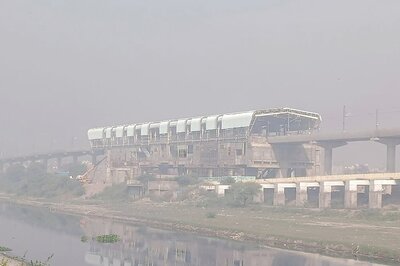
views
Curators are making hard choices at the museum memorializing the Sept. 11, 2001 attacks at the site of the World Trade Center's toppled twin towers, aiming to convey the horror of the event without trespassing into ghoulishness.
"We're not here to traumatize our visitors," said Alice Greenwald, director of New York's 9/11 Memorial Museum that is due to open in its underground home at the Ground Zero site next year on the 11th anniversary of the attacks.
"Monumental artifacts are one thing, but we also have a human story to tell," Greenwald said.
Some of the most potentially disturbing exhibits are being set aside from the main exhibition spaces in special alcoves to allow visitors a chance to decide whether or not to view it.
It is here that museum curators have placed material such as images of people plummeting from the burning towers after the buildings were struck by airliners hijacked by al Qaeda militants, and a recording of the measured voice of a flight attendant aboard one of the planes moments before her death.
For museum curators, deciding whether to include examples of some victims' painful final moments was one of their toughest dilemmas as they sought to pay tribute to the nearly 3,000 people killed without piling more grief onto the living.
It's a familiar problem for people aiming to memorialize wars and atrocities.
"We're not just a history museum, we're also a memorial institution and so the tension that happens between commemoration and documentation is a flash point," Greenwald said in an interview at the museum's offices overlooking the ongoing construction of a facility that will occupy seven stories below ground at the World Trade Center site.
Greenwald is no stranger to these debates. For almost two decades she helped create exhibits at the National Holocaust Museum in Washington memorializing the murder of millions of people at the hands of the Nazis during World War Two.
THE 9/11 STORY
Greenwald and her colleagues are aware that there are countless objects that might overwhelm a visitor. There will be photos of the 19 al Qaeda hijackers, although Greenwald said they will be presented as 'criminals.'
Another difficult question for curators was whether to include disturbing pictures of victims who jumped or fell from the towers. Excluding such pictures would be a serious omission, Greenwald said.
The photos will be located in an alcove clearly marked with a warning and none of the people pictured are identifiable, she added.
"It is one of the aspects of the 9/11 story that if you didn't include it, you're not telling the story," she said.
In choosing audio recordings of the last words spoken by some victims, the museum avoided some of the most distressing calls to the 911 emergency phone number.
"That's a form of human remains," Greenwald said. "We will include nothing that feels like a moment when we shouldn't have been there." Instead, curators chose recordings with the permission of victims' families that show what Greenwald called the 'exceptional nature' of many of those killed in the attacks.
This includes the remarkably composed voice of Betty Ong, a flight attendant on American Airlines Flight 11, as she relays details of the bloody hijacking to colleagues on the ground in the minutes before the plane crashed into the North Tower.
The museum has acquired hundreds of items belonging to victims, survivors and first responders. The significance of a horribly crushed fireman's helmet is obvious.
Other items might be more subtle in their importance; dust-caked shoes, a crumpled wallet, clothing, a never-finished knitting project, a blackened doll, all commonplace items that have taken on the air of relics.
The museum has been sculpted out of the vastness of the World Trade Center's foundations, and incorporates part of the slurry wall, originally built to hold back the waters of the Hudson River and which survived the buildings' collapse.
There will be a memorial exhibition for the 2,982 people killed in the Sept. 11 attacks and in the 1993 bombings of the World Trade Center that were a prelude to the later event.
The exit of the museum has been designed so that visitors emerge at the heart of the 9/11 Memorial, cascading waterfalls set into the footprints of the fallen towers surrounded by bronze panels bearing the names of the dead.
"For every heart-wrenching story you have 10 stories about the goodness of human beings," Greenwald said. Referring to future visitors to the museum, she added, "They're going to come out with a lot to think about."


















Comments
0 comment